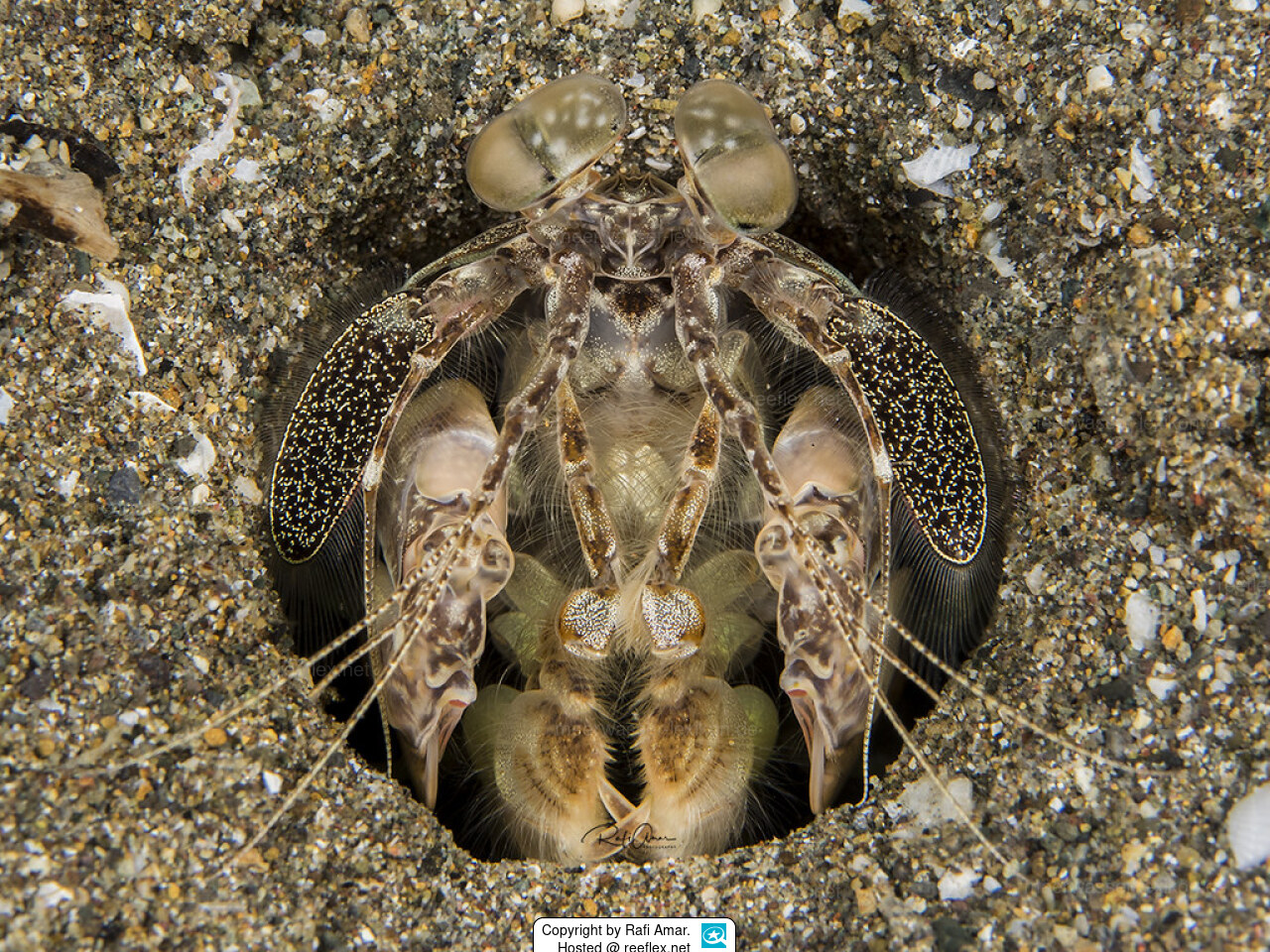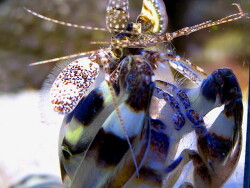Info
(Fabricius, 1793)
Interesting facts about keeping them can be found on Timmy Grohrock's very interesting homepage [see links].
It should be noted that this spear mantis shrimp can hardly be introduced with stones. It lives on/sandy soils.
General information:
Mantis shrimps belong to the family of mouth feeders, the so-called stomatopods.
There are around 390 species of mantis shrimp.
The crustaceans live in the coastal sea, rarely at very great depths.
A large number of species live on coral reefs in particular.
The genera Lysiosquilla, Gonodactylus and Odontodactylus live on Caribbean and Indo-Pacific coral reefs.
The size of the mantis shrimp varies from 1 to 2 cm to well over 30 cm.
Mantis shrimps can be brightly colored, for example in grey-green, brown and red, whereby the different colors describe the respective condition of the animal (red means danger, for example).
The strongly emphasized abdomen of the crustacean is equipped with a powerful tail fan and allows jerky, fast swimming strokes.
The legs: On the elongated body, the first pair of legs forms a cleaning organ covered with brushes.
The second pair of maxillipeds are the enormous clubs to which the butterfly owes its name.
At rest, they are usually carried on the front of the body, from where they can spring out in a flash.
The three following legs serve as tentacles. They are equipped with spines and claws and can
Feeding
Because of the food requirements (whole dead fish or whole dead shrimp or other pieces of food) and / or imitation of a live animal and / or the dangerousness of the fish / crustacean (bite or puncture injuries to the keeper) should be
Sex and mating.
Mantis shrimp are separately sexed and the single sex is easily identifiable. Mating is difficult due to aggressiveness.
A very comprehensive care, identification and breeding description can be found at https://www.fangschreckenkrebse.de/.
Synonyms:
Cancer caroli Curtiss, 1938 · unaccepted > junior subjective synonym
Lysiosquilla miersi de Vis, 1883 · unaccepted > junior subjective synonym
Lysiosquillina maculata (Fabricius, 1793) · unaccepted (superseded combination)
Squilla maculata Fabricius, 1793 · unaccepted > superseded combination (Basionym)
Interesting facts about keeping them can be found on Timmy Grohrock's very interesting homepage [see links].
It should be noted that this spear mantis shrimp can hardly be introduced with stones. It lives on/sandy soils.
General information:
Mantis shrimps belong to the family of mouth feeders, the so-called stomatopods.
There are around 390 species of mantis shrimp.
The crustaceans live in the coastal sea, rarely at very great depths.
A large number of species live on coral reefs in particular.
The genera Lysiosquilla, Gonodactylus and Odontodactylus live on Caribbean and Indo-Pacific coral reefs.
The size of the mantis shrimp varies from 1 to 2 cm to well over 30 cm.
Mantis shrimps can be brightly colored, for example in grey-green, brown and red, whereby the different colors describe the respective condition of the animal (red means danger, for example).
The strongly emphasized abdomen of the crustacean is equipped with a powerful tail fan and allows jerky, fast swimming strokes.
The legs: On the elongated body, the first pair of legs forms a cleaning organ covered with brushes.
The second pair of maxillipeds are the enormous clubs to which the butterfly owes its name.
At rest, they are usually carried on the front of the body, from where they can spring out in a flash.
The three following legs serve as tentacles. They are equipped with spines and claws and can
Feeding
Because of the food requirements (whole dead fish or whole dead shrimp or other pieces of food) and / or imitation of a live animal and / or the dangerousness of the fish / crustacean (bite or puncture injuries to the keeper) should be
Sex and mating.
Mantis shrimp are separately sexed and the single sex is easily identifiable. Mating is difficult due to aggressiveness.
A very comprehensive care, identification and breeding description can be found at https://www.fangschreckenkrebse.de/.
Synonyms:
Cancer caroli Curtiss, 1938 · unaccepted > junior subjective synonym
Lysiosquilla miersi de Vis, 1883 · unaccepted > junior subjective synonym
Lysiosquillina maculata (Fabricius, 1793) · unaccepted (superseded combination)
Squilla maculata Fabricius, 1793 · unaccepted > superseded combination (Basionym)







 Rafi Amar, Israel
Rafi Amar, Israel
















